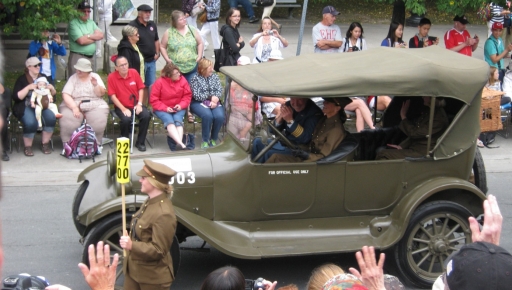The Warriors’ Day Parade in Toronto, Canada, this year commemorated the start of the First World War. Centenary News writer Christopher Harvie attended the parade, and has sent this report on today’s event.
A cool, calm morning is opening up and the grandstands just beyond the Prince’s Gates are beginning to fill in anticipation of the Warriors’ Day Parade held at the Canadian National Exhibition.
Many here have arrived early to get a good seat for an old Toronto tradition. Begun informally in 1921 by veterans of the Great War, the Warriors’ Day Parade quickly became a feature of the Exhibition and usually marked its opening.
By 1926, it was part of the official catalogue and was referred to as Warriors’ Day. By then it included ex-service men of all wars. It was organized in large part by the Canadian Legion of the British Empire Service League, founded in November of 1925. Among its aims were the unity of veterans, the spirit of comradeship, and the promotion and preservation of records and memories.
Listening carefully, it’s just possible to hear pipers tuning up, haunting notes carried on a light breeze. Already there are many different uniforms in view, serving members and veteran’s groups representing all branches of service and several foreign countries as well.
It’s heartening to see such enthusiasm, and lends a lot to the notion that we here in Canada have not forgotten sacrifices made on our behalf.
Of course, it’s far too late for any First World War veterans, but they are remembered today in spirit and perpetually by the continued tradition of those who came after.
The parade opens with a fly over of two replica aircraft built from World War One designs from the Great War Flying Museum of Brampton, Ontario. Both planes flew in tight formation several circuits overhead to great acclaim from the crowd. As the S.E. 5a and Sopwith Strutter headed west for their home field, the Honour Section was preparing to step off the ground component of the parade.
This year, the Honour Section was comprised of elements reflecting the centenary of World War One and included various living history groups, both mounted and on foot and a brand new historical interpretation society, making their debut at this prestigious event.
A 1917 staff car and two motorcycles of WWI vintage are just a few of the authentic period vehicles in the collection of Warmotion, “a travelling exposition…that brings the sights, sounds, touch and taste of the Great War to life.”
Sue Schroeter, Project Manager of Warmotion, says of the parade: “The Warriors’ Day Parade is commemorating the 100th anniversary of the beginning of the First World War. It is the perfect day to launch Warmotion. This rare Canadian collection of vehicles and wartime stories create a living tribute to the Canadian men and women who served our country from 1914-18, and also to those who serve in our military today.”
Following the Honour Section, the parade continues with representatives of today’s Canadian Forces, various local Legion branches, and groups of veterans from WWII, Korea and UN Peacekeeping operations.
International veterans were also included, from the United States, South Korea, the Republic of China (Taiwan), Vietnam and Ghana. Community, military and first responder marching bands provided music and cadence for those in the order of march, the audience clapping in admiration as each group passed.
Traditionally, when the parade finishes, the “Ex” is officially open and large crowds made their way to the variety of food stalls or the rides and games of the midway. I went into the Direct Energy Centre to seek out the Canadian Armed Forces Display.
Approaching this display is an avenue of large posters compiling photographs and information on the First World War put together with the co-operation of the CNE Archives, the 48th Highlanders Regimental Museum and the Archive of Ontario. The posters give a perspective on aspects of the war, from life at the training camp instituted at the CNE in 1914, to the production of “trench art.”
There was a static display as well, put together by The Hamilton Signals Association. This association is a non-profit group who recreate and preserve old equipment used for military communication. In regards to the parade having commemorated the Centenary, the HSA established their display with period authentic equipment, their volunteers turned out in WWI khaki service dress.
Association President, Major Ken Lloyd spoke to me at length about the uses of various types of signalling devices, including field telephones, runners, pigeons, dogs and heliographs, a means of sending light signals by use of a mirror reflecting the sun’s rays.
Quite an expert in his field and its history, Major Lloyd gave me some interesting facts; “Signallers were often unarmed. There’s a record of a letter from one young man in the signals corps asking his father at home to send him a revolver.”
Though not carrying weapons, “these men were often awarded the Military Medal, mostly for not abandoning their post and continuing to relay messages while under fire or gas attack.” It is his goal to develop an educational program which can be taken to schools in the area to help new generations understand something of the war.
The idea behind groups such as The Great War Flying Museum, Warmotion and the Hamilton Signals Association is to preserve elements of history and demonstrate uniforms and equipment in an educational context.
No longer able to rely on those with living memory to give perspective, it becomes the mandate of these groups to give something tangible to history which allows the present to connect with the past.
Posted by: CN Editor
